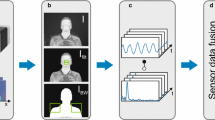Abstract
Objective
By observing body surface temperature variation of the intermediate structures of the Lung (Fei) and Large Intestine (Dachang) exterior-interior relationship in asthmatic patients, to investigate the pathological response on the pathway of channels and to substantiate the objective existence of the intermediary structures.
Methods
The study included 60 subjects meeting the bronchial asthma inclusion criteria (experimental group) and 60 healthy subjects (normal control group). ATIR-M301 infrared thermal imaging device was used for detecting body surface temperature of the subjects and collecting the infrared thermal images. The temperature values of the intermediate structures of Lung and Large Intestine exterior-interior relationship [throat, Quepen, elbow, nose, Lieque (LU 7), Pianli (LI 6)], control areas (0.2 cm lateral to the above structures) and Yintang (EX-HN 3) were measured on the infrared thermal image by infrared imaging system. Then, the above temperature values were compared and analyzed within and between two groups.
Results
There were insignificant differences between the temperature on the left and right sides of the intermediate structures (Quepen, elbow, LU 7, LI 6) in normal control group (P>0.05). Except for that of Quepen, there were insignifificant differences between the temperature of the intermediate structures and their corresponding control areas in normal control group (P>0.05). In the experimental group, the temperature on the left and right sides of the intermediate structures (Quepen, elbow, LU 7, LI 6) showed statistically signifificant differences (P<0.05 or P<0.01); the temperature difference between intermediate structure (throat, Quepen, elbow, nose, LI 6) and their respective control areas were also significant (P<0.05 or P<0.01). The temperature of the intermediate structures (throat, Quepen, elbow, LU7, LI 6) between the experimental group and normal control group showed signifificant differences (P<0.05 or P<0.01).
Conclusions
This study is an initial step to validate the objective existence of Lung and Large Intestine exterior-interior relationship intermediate structures, as described in the Chinese classical medical literatures, through the functional imaging angle. The intermediate structures are the pathological reaction areas of the bronchial asthmatic patients.
Similar content being viewed by others
References
Gao L, Wang J. Research of Zang-Fu interior-exterior relationship theory. Chin J Basic Med Tradit Chin Med (Chin) 2010;16:271–273.
Ling ZY. Meridians and collaterals foundation of the Zang-Fu interior-exterior relationship. J Sichuan Tradit Chin Med (Chin) 2005;23(10):3–4.
Song M, Wang YM. Combination treatment of lung and large intestine meridian for acute attack of bronchial asthma. Guangming J Tradit Chin Med (Chin) 2005;20(1):5–6.
Liu B, Wang J, Zhao JP. Intermediate structure of the interior-exterior relationship between lung and large intestine. Chin Acupunct Moxibust (Chin) 2011;31:363–365.
Respiratory Disease Branch of Chinese Medical Association. Guidelines for the prevention and treatment of bronchial asthma. Chin J Asthma (electronic version, Chin) 2008;31(31):177–185.
World Health Organization Regional Office for Western Pacific. WHO Standard Acupuncture Point Locations in the Western Pacific Region. 2009 revised ed. Beijing: People’s Medical Publishing House; 2010:23–223.
Wu Q, ed. Golden mirror of medicine • bone setting heart law gist. Beijing: People’s Medical Publishing House; 1963:32.
Tian P, Sun LB. Application of infraned thermogram in Clinic. Modern Med Health (Chin) 2001;17:742–743.
Tian DH, Liu GS. Ling Shu Miraculous Pivot. Beijing: People’s Medcial Publishing House; 2005:4–8.
Zhao JP, Liu B. Research on intercommunication base of meridian and acupoints inexterior-interior relation between lung and large intestine. J Beijing Univ Tradit Chin Med (Chin) 2010;33:592–594.
Zhang LQ. Chinese medicine human body is a complex giant system of scientific theory building. Guangming J Tradit Chin Med (Chin) 2009;24:2189–2193.
Lin XY, Li XL. Read the exterior-interior relationship of the meridians and collateral channels and Zang-Fu in Inner Canon of Huangdi. J Shanxi Coll Tradit Chin Med (Chin) 2007;30(6):47–48.
Liu B, Zhao JS. Interior-exterior relation of meridians under two meridian modes. Chin J Acupunct Moxibust (Chin) 2011;31:526–528.
Zhang TN, Zhou MQ, Wu SB, Cao J, Gao F, Sheng HM. Exterior-interior correlation of “Heart” and body surface based on researches of classic literature and modern animal experiments. Acupunct Res (Chin) 2013;38:78–82.
Yang WY, Zhou WX, Sun KX. Research of acupoints ultra weak luminescence in the disease states. Shanghai J Acupunct Moxibust (Chin) 1998;17(6):2–3.
Sun PS, Zhao YZ, Li CL, Li YL, Liu H, Yan QL. The detection of the surface circulation route of large intestine meridian of hand yangming in index of quantitative low frequency sound. Liaoning J Tradit Chin Med (Chin) 1993;(11):33–36.
Wang CH, Wang SL, Fan WH, Wang GB. Research on modern research methods of lung and large intestine interior-exterior relationship theory. Lishizhen Med Mater Med Res (Chin) 2010;21:1287–1289.
Li JH, ed. Diagram analysis of infrared thermal imaging technology in clinical application. Beijing: People’s Medical Publishing House; 2009:36–37.
Zhu M, Li YH, Lin TX, Yue ZR, Jing DM, Ge F. Application of TTM system for testing Chinese herbal nature. Chin J Stereol Image Analy (Chin) 2007;12(1):53–58.
Hu XL, Wang PQ, Xu JS, Wu BH, Xu XY. Research on the main features and the laws of appearance of the infrared radiant track on the human body. J Infrar Mill Waves (Chin) 2001;20:325–330.
Chen BJ, Qu XX, Zhang D, Li SY, Song XJ, Ma HM. Observation of symmetry of facial acupoint temperature with acupuncture adjustment in facial paralysis patients. Chin J Basic Med Tradit Chin Med (Chin) 2011;17:556–559.
Zhou D, Chen G. Introduction of the meridians and collateral evaluation diagnosis method. J Sichuan Tradit Chin Med (Chin) 1996;14(4):53–54.
Xing JH, Yuan CH, Gu XJ, Liu WP. Observation on regularity of disease transmission and meridian imbalance. Chin Acupunct Moxibust (Chin) 1995;Supl 2:21–23.
Author information
Authors and Affiliations
Corresponding author
Additional information
Supported by National Basic Research and Development Program (973 Program, No. 2009CB522708)
Rights and permissions
About this article
Cite this article
Fu, Y., Ni, Jx., Marmori, F. et al. Infrared thermal imaging-based research on the intermediate structures of the lung and large intestine exterior-interior relationship in asthma patients. Chin. J. Integr. Med. 22, 855–860 (2016). https://doi.org/10.1007/s11655-016-2102-4
Received:
Published:
Issue Date:
DOI: https://doi.org/10.1007/s11655-016-2102-4




